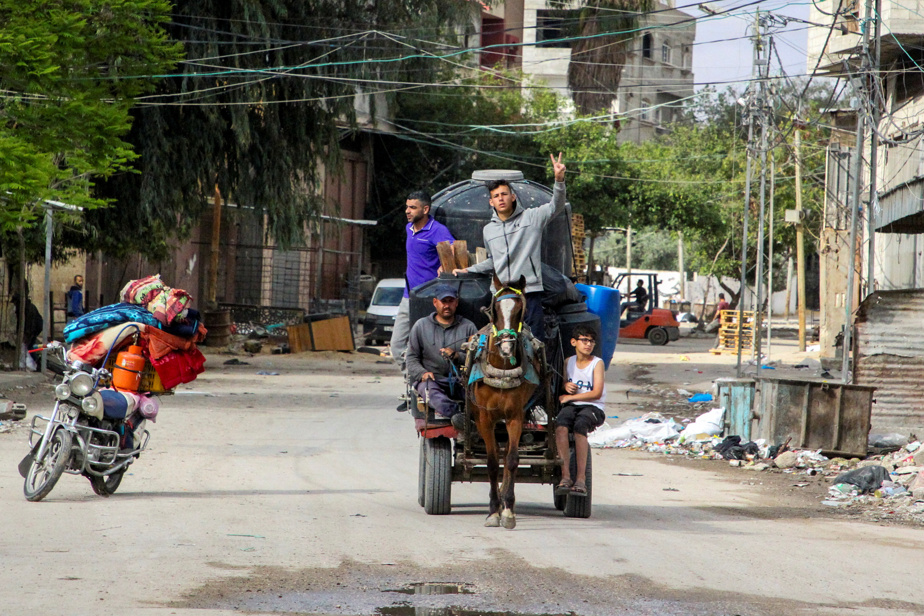(Rafah) Deadly Israeli strikes and ground operations show no respite in the besieged and famine-threatened Gaza Strip, more than seven months after the start of the war which has claimed the lives of more than 35,000 Palestinians according to Hamas on Sunday.
The major offensive by the Israeli army, triggered by an unprecedented bloody attack by the Palestinian Islamist movement Hamas against Israel on October 7, has devastated the small, overpopulated Palestinian territory, where according to the UN there is no longer “any safe place” for the approximately 2.4 million inhabitants.
The greatest international fears today concern the town of Rafah, in the far south of the Gaza Strip, and the approximately 1.4 million Palestinians crowded there, the majority displaced by destructive bombings and fighting. .
Israel, which has sworn to annihilate Hamas, wants to launch a ground offensive in Rafah, which it considers to be the last bastion of the movement in the Palestinian territory besieged by its army since October 9.
But for US Secretary of State Antony Blinken, whose country is hostile to a major assault in Rafah, “there will always be thousands of armed Hamas members”, even with such an intervention. An offensive would risk creating “chaos” and ultimately a return of Hamas, he said on NBC.

PHOTO EVELYN HOCKSTEIN, REUTERS ARCHIVES
Anthony Blinken
According to AFP correspondents and witnesses, Israeli air raids targeted several sectors of Palestinian territory including Rafah.
“Israeli military vehicles advanced about 2.5 kilometers deep” from Rafah, said Gaza crossings authority spokesman Hicham Adwan.
The army said its troops were continuing “targeted” operations in eastern Rafah, and “ten Hamas terrorists were eliminated there.”
In the past 24 hours, at least 63 additional deaths have been recorded in Gaza, the Hamas health ministry said. A hospital in Rafah announced that it had received the bodies of 18 people.
“There is no safe place in Gaza”
“The artillery fire never stopped […] For a moment, we had the impression that they (Israeli soldiers) were at our door,” Mohammed Hamad, a resident of eastern Rafah who had to flee to the west of Rafah, told AFP. the city.

PHOTO HATEM KHALED, REUTERS
A Palestinian flees Rafah after Israeli forces launched a ground and air operation in the eastern part of the city, May 12
After evacuation orders issued by the army, some 300,000 residents of eastern Rafah left the area, a military statement said, specifying that the areas to be evacuated were “the scene of Hamas terrorist activities.” .
Warning of “the possibility of further atrocious crimes” in the event of a large-scale offensive in Rafah, Volker Türk, UN High Commissioner for Human Rights, denounced the evacuation orders, stressing that the towns supposed to receive displaced people are already “reduced to ruins”.
“The latest evacuation orders affect nearly a million people in Rafah. Where should they go now? There is no safe place in Gaza,” he said.
By attacking Rafah, Israeli Prime Minister Benjamin Netanyahu wanted to “derail” the talks with a view to a truce and the release of hostages held in Gaza since October 7, Hamas accused in a statement.
Hamas said it had accepted a proposal from mediators (Egypt, Qatar, United States) on a truce, but Israel responded that the accepted proposal was “far from (its) demands”.
“Hamas is trying to rebuild itself”
In the north of the Gaza Strip, the army also issued orders to evacuate Jabaliya, after reporting “attempts by Hamas to rebuild its military capabilities in Jabaliya.” Troops are carrying out operations in this area as well as in the Zeitoun neighborhood of Gaza City, she added.
Considered a terrorist group by Israel, the European Union and the United States, Hamas took power in Gaza in 2007. Before the war, this strip of land, 40 km long and 10 km wide, had been subject to an Israeli air, land and sea blockade since 2007.

PHOTO MENAHEM KAHANA, AGENCE FRANCE-PRESSE
Israeli military vehicles drive near the border with the Gaza Strip on May 12.
On October 7, Hamas commandos infiltrated from the neighboring Gaza Strip in southern Israel launched an attack which left more than 1,170 dead, mostly civilians, according to an AFP report based on official data. Israelis. More than 250 people were kidnapped during the attack and 128 remain captive in Gaza, of whom 36 are believed to have died, according to the army.
In response, the Israeli army launched intense aerial bombardments followed by a ground offensive on October 27, which caused colossal destruction, displaced the majority of the population and caused a humanitarian catastrophe with an imminent risk of famine according to the UN and a heavy human toll: 35,034 deaths, the majority of them civilians according to the Hamas Ministry of Health.
Two billion dollars

PHOTO TONY KARUMBA, AGENCE FRANCE-PRESSE
UN chief Antonio Guterres
According to the Israeli army, 272 of its soldiers have been killed in the military campaign on Gaza since October 27.
UN boss Antonio Guterres reiterated “the entire world’s call for an immediate humanitarian ceasefire, the unconditional release of all hostages” and “an immediate increase in humanitarian aid”.
He was speaking at an international conference in Kuwait where donors pledged more than $2 billion over two years for humanitarian operations in Gaza.
The entry of aid into Gaza has been virtually blocked, according to the UN, since Israeli troops entered eastern Rafah on Monday and seized the border crossing with Egypt, blocking a key gateway for convoys. help.
